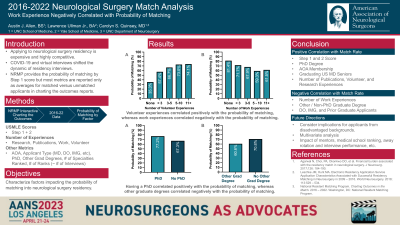2016-2022 Neurological Surgery Match Analysis: Work Experience Negatively Correlated with Probability of Matching
Friday, April 21, 2023

Has Audio

Austin J. Allen
Medical Student
UNC School of Medicine
Chapel Hill, North Carolina, United States
ePoster Presenter(s)
Introduction: The selection of applicants for neurological surgery residency positions is highly competitive. Prior work has characterized variables associated with improved match rates; however, no studies have been published since the transition to virtual interviews.
Methods: The National Residency Matching Program Interactive Charting Outcomes in the Match tool was used to secure data on characteristics of neurological surgery applicants between 2016 and 2022. The probability of matching (POM) was computed for each subgroup classification for applicant characteristics versus the average match rate for all applicants. Risk difference was tabulated by comparing the match rate for a specific characteristic versus the national average for all applicants. The change in POM for each sub-classification of contiguous variables was also tabulated. Two-tailed probability values were calculated and considered significant for p-values < 0.05.
Results: Notable characteristics that significantly increased the POM included a Step 1 score > 240 (RD 3.9%, p=.005) or 250 (RD 14.5%, p< 0.001), being a US MD applicant (RD 12.3%, p< 0.001), a Step 2 score > 250 (RD 13.2%, p< 0.001), AOA membership (RD 22.8%, p< 0.001), and having a PhD degree (RD = 9.0%, p< 0.001). A non-PhD graduate degree decreased the POM (RD -7.7%, p< 0.001), and the number of work experiences (WE) was negatively correlated with POM (81.4% POM for no WE, 71.7% for 1-3 WE, 67.9% for 3-5 WE, and 59.3% for 5-10 WE).
Conclusion : Step 1 scores > 240, Step 2 scores > 250, AOA membership, being a US MD applicant, and possessing a PhD degree are associated with an increased POM. Paradoxically, an increasing number of WE and a non-PhD graduate degree are associated with a decreased POM. Further study is necessary to better understand these trends, particularly for students from a low socioeconomic background who may need to work to afford advanced educational training.
Methods: The National Residency Matching Program Interactive Charting Outcomes in the Match tool was used to secure data on characteristics of neurological surgery applicants between 2016 and 2022. The probability of matching (POM) was computed for each subgroup classification for applicant characteristics versus the average match rate for all applicants. Risk difference was tabulated by comparing the match rate for a specific characteristic versus the national average for all applicants. The change in POM for each sub-classification of contiguous variables was also tabulated. Two-tailed probability values were calculated and considered significant for p-values < 0.05.
Results: Notable characteristics that significantly increased the POM included a Step 1 score > 240 (RD 3.9%, p=.005) or 250 (RD 14.5%, p< 0.001), being a US MD applicant (RD 12.3%, p< 0.001), a Step 2 score > 250 (RD 13.2%, p< 0.001), AOA membership (RD 22.8%, p< 0.001), and having a PhD degree (RD = 9.0%, p< 0.001). A non-PhD graduate degree decreased the POM (RD -7.7%, p< 0.001), and the number of work experiences (WE) was negatively correlated with POM (81.4% POM for no WE, 71.7% for 1-3 WE, 67.9% for 3-5 WE, and 59.3% for 5-10 WE).
Conclusion : Step 1 scores > 240, Step 2 scores > 250, AOA membership, being a US MD applicant, and possessing a PhD degree are associated with an increased POM. Paradoxically, an increasing number of WE and a non-PhD graduate degree are associated with a decreased POM. Further study is necessary to better understand these trends, particularly for students from a low socioeconomic background who may need to work to afford advanced educational training.
